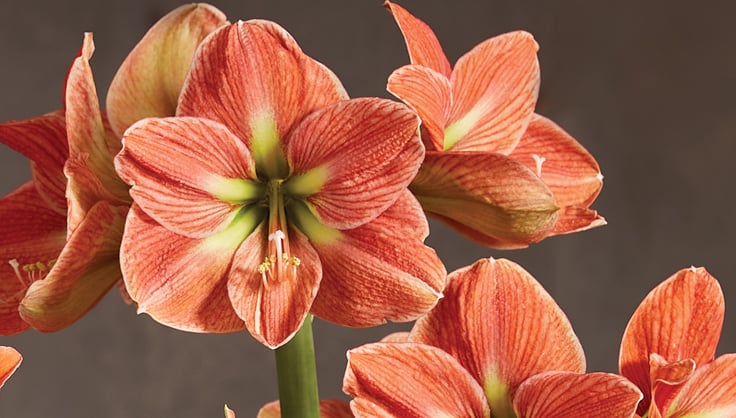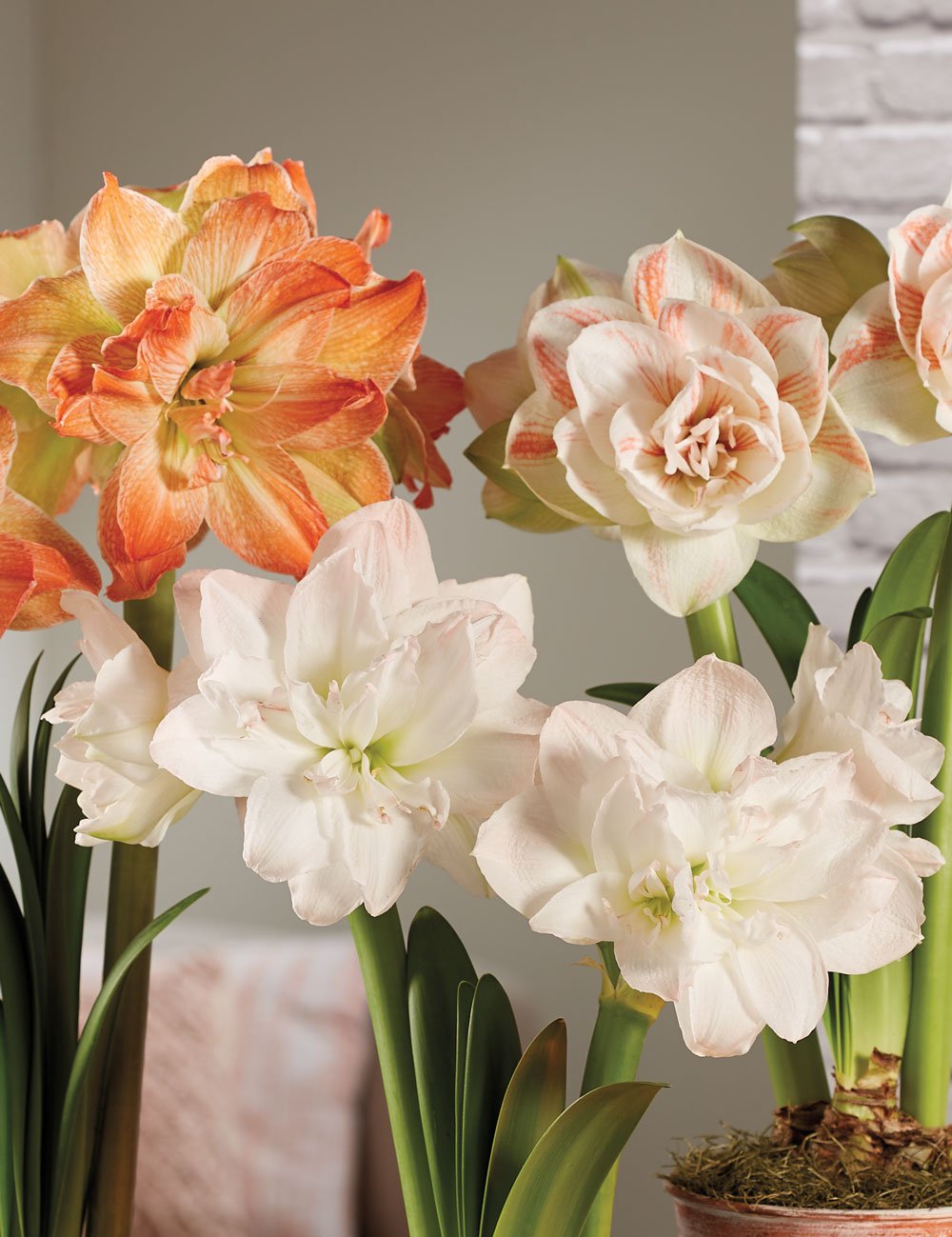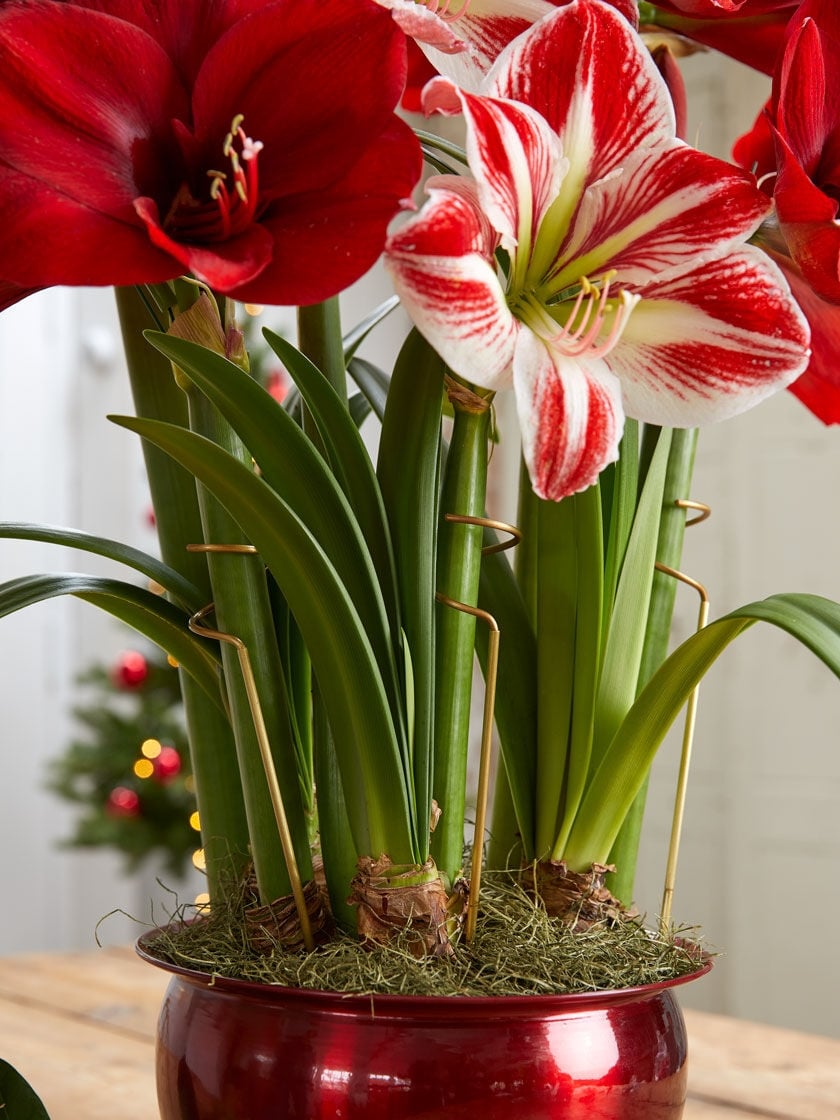Amaryllis Care
How to Plant, Grow – and Rebloom – these Holiday Favorites
 Amaryllis are rewarding, easy-care houseplants that really brighten a winter windowsill.
Amaryllis are rewarding, easy-care houseplants that really brighten a winter windowsill.Few bulbs are easier to grow than amaryllis — and few bloom with greater exuberance and beauty. Just plant the bulb in good potting soil, water regularly and provide bright, indirect light. A support stake is handy for keeping the blooms upright, but little else is required. Most varieties will begin blooming six to eight weeks after planting; some can take as long as ten weeks.
 Mystica, Evergreen, and Chico potted amaryllis.
Mystica, Evergreen, and Chico potted amaryllis.If your amaryllis is not already potted, plant each amaryllis bulb in a 6-8" pot. Heavy pots are preferable because lightweight pots may tip over under the weight of the blooms.
Plant the bulb, pointed-end-up, in potting mix. Pack the soil gently around the bulb so approximately one-third of the bulb remains above the soil line.
Important: do not use soil from the garden because it will not drain properly.
Place the pot in a location that receives bright, indirect light. Water sparingly until you see about 2" of new growth. From then on, water regularly. As the plant grows, turn the pot periodically to encourage the flower stalks to grow straight. Flower buds will appear at the top of each stalk, followed by a dramatic floral display. To prolong the blooms, keep the pot out of direct sunlight.
When Will It Bloom?
This chart gives you an idea of when you're amaryllis will bloom relative to the planting date. It usually takes six to eight weeks for amaryllis to bloom, but check the label on the variety you have — some bloom faster, and some slower.
| Planting date | Bloom timeframe |
| Oct. 15 | Nov. 19-Dec. 10 |
| Nov. 1 | Dec. 6-27 |
| Nov. 15 | Dec. 20-Jan. 10 |
| Dec. 1 | Jan. 6-28 |
| Dec. 15 | Jan. 19-Feb. 9 |
| Jan. 1 | Feb. 6-26 |
| Jan. 15 | Feb. 19-March 12 |
| Feb. 1 | March 8-29 |
| Feb. 15 | April 5-26 |
 Double-flowered potted Nymph amaryllis.
Double-flowered potted Nymph amaryllis.Frequently Asked Questions
Q. My amaryllis is sprouting leaves, but no flower stem yet. Does this mean it won't bloom?
A. Some amaryllis bulbs sprout leaves first, and then the flower stalk emerges a little later. Others send up the flower stalk first, followed by the leaves. You should see the flower stalk peeking up between the leaves soon.
Q. Do I need to fertilize my amaryllis?
A. The stored bulb contains all the "food" your amaryllis needs to sprout and bloom. If you decide to keep your amaryllis for reblooming next year, you'll need to fertilize it like you would any houseplant. Details below ("For Bloom Next Year").
Q. Can I use the blooms as cut flowers?
A. Yes! Amaryllis are becoming popular cut flowers, and, surprisingly, they often last longer in a vase — up to two weeks! — than they do when left growing on the plant. Instead of relegating a tall amaryllis to a windowsill or sideboard, you can create a dramatic dining table centerpiece by using a relatively low vase and combining your amaryllis blooms with other flowers and foliage.
Q. How many flower stalks will my bulb produce?
A. This depends on the variety of amaryllis, and the quality and size of the bulb. In general, the larger the bulb (for the particular variety) the more flower stalks you'll get. When it comes to amaryllis bulbs, bigger is better.
Q. Do I leave the faded flowers on the plant or "deadhead" like I do my outdoor plants?
A. As individual flowers start to fade, you can carefully snip them off. Once all flowers on a flower stalk has faded, cut the stem back to within a few inches of the bulb.
More tips and advice from Laura at Garden Answer.
For Blooms Next Year
Amaryllis can be encouraged to blossom again the following year. It takes a little planning and extra care, but is quite simple and very rewarding. After the flowers have faded, cut the flower stalk to within 1" of the top of the bulb. Continue to water and feed the plant regularly with a liquid houseplant fertilizer. Amaryllis will grow a number of leaves during the spring and summer. This will help the plant produce energy for the following year's bloom. In mid-August, begin withholding water and let the foliage die back naturally as the pot dries out completely.
Store the dormant bulb in a cool, dark and dry place for a minimum of eight weeks; longer is fine. Then, about six to eight weeks before you want the amaryllis to flower again, repot the bulb in fresh potting soil and place it in bright, indirect light. Resume watering — sparingly at first. Once you see new growth, increase watering and look forward to the upcoming flower show. By following these basic care guidelines, you will be able to encourage your amaryllis to flower year after year.
Last updated: 03/21/2024
Print this Article:
Related items
Related Articles
Get the Dirt
Stay up to date on new articles and advice. Please fill out the information below.






